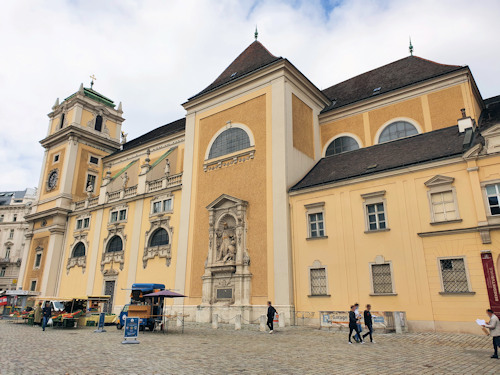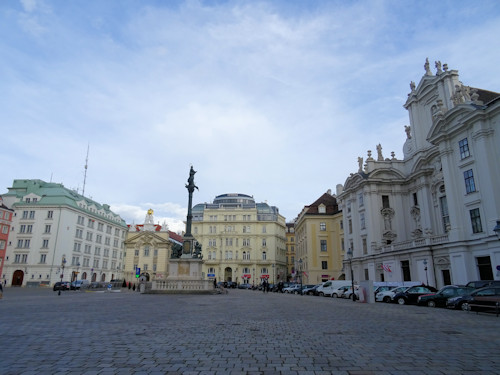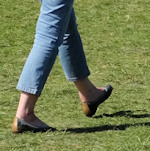
The final part of our self-guided walking tour of Vienna moves away from the Ring to go back through the old town to Stephansdom cathedral via a couple of historical squares.
Follow the route outlined below and discover bonus tips on locations, as well as links to detailed information on what you see.
- The entire 4-part walk takes some 1½ hours without too many pauses and breaks
- Book a guided walking tour* of the city
- See also:
Down to the cathedral
So Part 3 of the tour ended outside the Burgtheater. You’re going to move back into the old town through one or two locations that feel like they stepped right out of the past.
Route map
This article covers the black icons below:
The university
First walk just a little further around the Ring on the Burgtheater side, past Café Landtmann (one of Vienna’s famous coffee houses and a favoured haunt of the well-to-do).
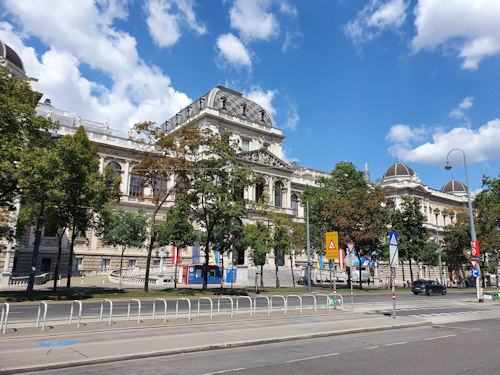
(The University of Vienna building)
This brings you to the 1890 memorial to Johann Andreas von Liebenberg (1627-1683), who was mayor of Vienna during the 1683 siege of the city and played a pivotal role in keeping the invaders at bay until help arrived.
Opposite Johann on the other side of the road you see the main entrance to the University of Vienna. Though built in 1884, the institution within dates back through the centuries to its founding in 1365.
You might recognise the entrance (and reading room inside) from the Sachertorte movie and the building also appears in The Woman in Gold.
The university’s arched Potteresque courtyard offers a home to numerous small busts and similar of famous academics of the past, including recognisable names like Freud, Popper, or Schrödinger.
Into the 1800s
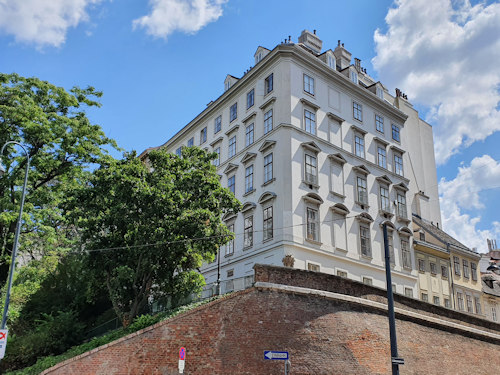
(Beethoven once looked out of those windows)
At the Liebenberg memorial, turn off right down Schreyvogelgasse, keeping the large brick wall on your left.
The house you see perched on top of that wall is the late 18th century Pasqualatihaus, once home to a certain Ludwig van Beethoven and now home to a small museum. The composer spent his time there admiring the view, drinking coffee, and writing bits and pieces like Fidelio or Für Elise.
As you approach the end of the short road go up a small street on your left that slopes up and back toward the Pasqualatihaus.
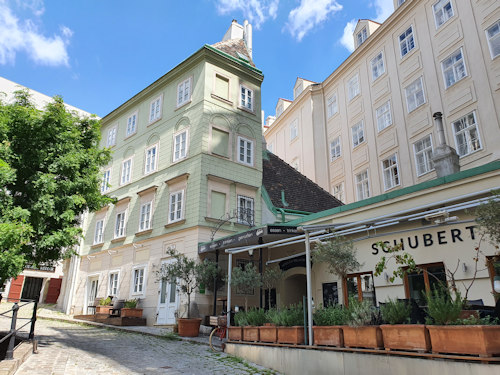
(Walk up here to enjoy the historical ambience)
If you wish to avoid slopes and some steps, continue down Schreyvogelgasse, turn left onto Teinfaltstraße, and rejoin the tour at the part marked Freyung below.
Most people miss this part of Vienna, which has such a (genuine) 1800s feel to it that you may find your way blocked by film crews using the location as a set.
This is also Third Man territory. You might recognise the doorway at No.8 on the rising road, where a significant character hid in the shadows.
Go up the slope and follow it round to the right and enjoy the dip into the past until you emerge at some steps that takes us back down into more modern times.
Walk down the steps and turn right to continue down Schottengasse until it reaches an open area with a church on your left.
Tip: you pass Café Diglas on Schottengasse. Go through and outside the back to find its open-air seating with tree shade...right in the middle of what is actually the Schottenstift abbey complex. Great for avoiding the crowds.
Freyung
(The Schottenkirche. The exterior relief honours Heinrich II Jasomirgott, abbey founder and first Duke of Austria)
The church you see on your left as you reach the open area is the 13th-century Schottenkirche (much changed since those days, though) and the square in front of it is the Freyung with its Austriabrunnen fountain.
Don’t follow the road to the left through the square. Instead, first walk down the right fork for a small detour into Herrengasse.
Herrengasse
This route takes you past the gorgeous early 18th-century Palais Kinsky; continue until you reach a junction, where you turn left onto Strauchgasse to return to the Freyung.
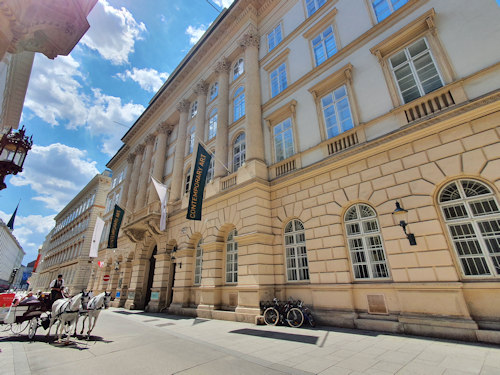
(Palais Niederösterreich)
That junction has two particular highlights for you:
- Palais Niederösterreich with 16th century origins and a history that includes hosting concerts by the likes of Beethoven and Liszt
- Café Central, a coffee house with possibly the most impressive café interior in all of Vienna. Trust me on this
Tip: Café Central nearly always has (long) queues. If you plan to stop here, make a reservation.
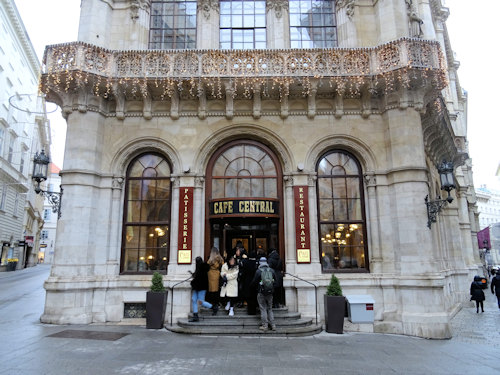
(Café Central during the Christmas season and early enough that queues had yet to build)
Strauchgasse takes you back to the bottom of the Freyung and a crossroads where you turn right to reach another historical square: Am Hof.
First, though, wander onto the Freyung to admire the surrounds, which include 18th-century apothecaries (still going at number 7), the abbey museum (notable for its 15th-century altar panels), and various townhouses erected by the nobility to ensure a shorter carriage ride to the Hofburg court.
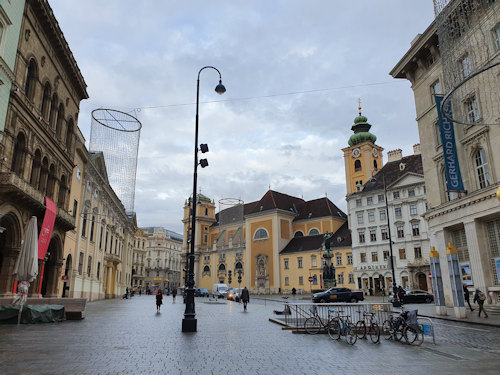
(The Freyung seen from the junction with Strauchgasse)
For a change of tone, the Bank Austria Kunstforum Wien also sits on that crossroads. This is one of Vienna’s most prestigious locations for exhibitions of modern and contemporary art, so do check what’s on.
The likes of Hockney, Kahlo, Man Ray, Chagall, Warhol, Basquiat, and similar have all featured at the Kunstforum in the past.
Am Hof
Leave the Freyung at that crossroads to quickly reach Am Hof square, where Vienna’s history kind of began back in Roman times.
(The Am Hof square with a Marian column in the middle)
The column you see in the centre is the Mariensäule, erected in 1667 to give thanks for Vienna escaping the attentions of rampaging Swedes (different times).
Am Hof has various historical buildings to consider, not least the giant 14th-century Kirche am Hof church with its Baroque façade. But take a peek at the unassuming building to the left of the church.
Back in 1762, guests at Palais Collalto might have been rather irritated at having to sit through a musical performance given by some six-year-old boy from out west.
Except that kid was a certain Wolfgang Amadeus Mozart giving his first public performance in Vienna. Imagine!
Tip: walk across Am Hof to the diagonal opposite of where you came in and slip through to find another historical square: Judenplatz has, for example, the Holocaust memorial and a Jewish Museum exhibition site.
Continue walking with the Am Hof square on your left to enter Bognergasse and the final pedestrianised part of our walking tour.
Graben
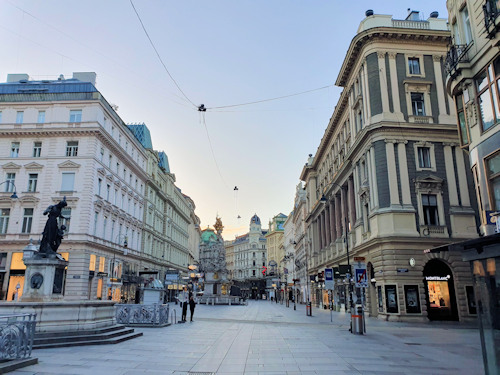
(The Graben street)
Bognergasse takes you past a couple of lovely Jugendstil buildings (look for the Engel Apotheke and the Zum Schwarzen Kameel café and restaurant). At the end, do a quick right and left to enter the Graben.
This long broad avenue represents the very heart of the city and is lined with (luxury) stores and nice-looking buildings such as the Grabenhof. Not so much a place to walk as to gently stroll.
Plague column & Peterskirche
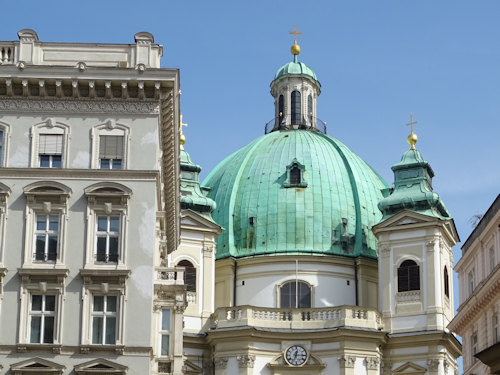
(The Peterskirche dome, modelled on the Vatican’s St. Peter’s Basilica)
The main feature on the Graben itself is the plague column, another 17th-century monument put up out of gratitude, this time for the end of a bout of bubonic plague.
Just before the plague column, though, look left to see the early 18th century Peterskirche church set back a little from the road.
This working church gives new meaning to the phrase “decorative interior.”
Tip: the Peterskirche provides a remarkable ambience for regular evening concerts of light classical music by the Classic Ensemble Vienna.
At the end of the Graben turn left to enter Stephansplatz square and its rather obvious highlight: Stephansdom cathedral.
(If you reach the end of the Graben and turn right, you find yourself on Kärntner Straße. Walk up to eventually reach the Staatsoper and thus go full circle back to the start of the tour route.)
Stephansdom
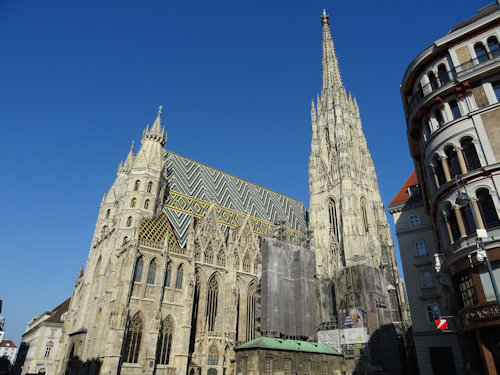
(The cathedral with the south tower on the right)
Vienna’s main landmark dates back seven or eight centuries, though the coloured mosaic roof is new thanks to WWII damage.
Stephansdom has free public access to the first part of the interior, but you need a ticket for more. That includes a tour of the catacombs with a few sights that have an Indiana Jones feel to them.
Tip: if you can handle the stairs, a trip up the cathedral's south tower ends in a remarkable view of Vienna and, particularly, the old town.
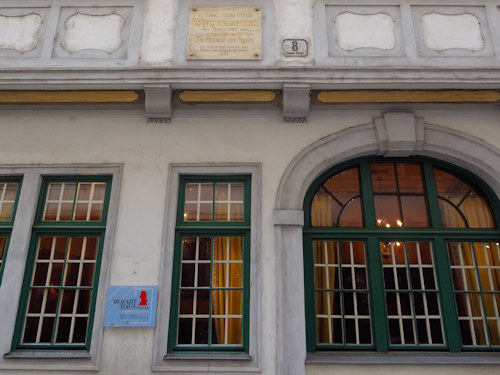
(The Mozarthaus: Mozart composed The Marriage of Figaro inside)
I’ll leave you to enjoy the cathedral as the final stop on our 4-part walking tour. But pop behind the building for three other immediate highlights:
- The Mozarthaus, where Mozart once lived and now an excellent museum to the musical genius.
- The Dom Museum with its mix of art and ecclesiastical treasures
- The Haas&Haas tea rooms, fighting a leafy fight against the all-powerful coffee houses.
Final tip: for those intimidated by the prospect of all that walking, consider a hop on hop off bus tour instead!
